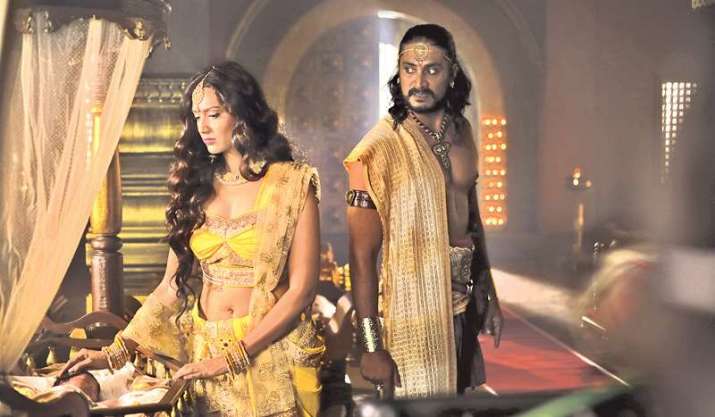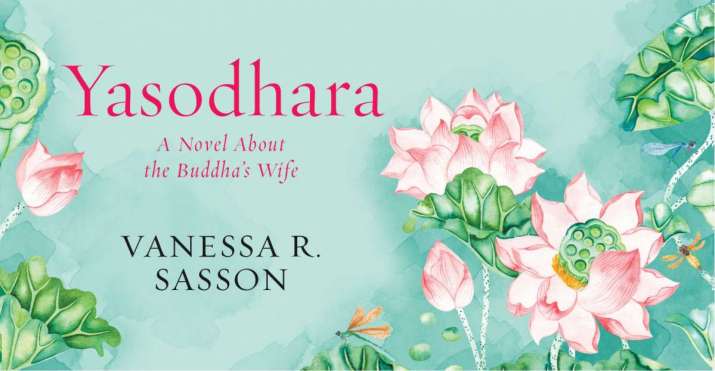FEATURES|THEMES|Books and Literature
Yasodhara: Retellings and Hagiographies of the Buddhist Feminine
 Indian actress Pallavi Subhash in her Sinhalese debut as Yasodhara in the biopic Bimba Devi Alias Yashodhara. From dailynews.lk
Indian actress Pallavi Subhash in her Sinhalese debut as Yasodhara in the biopic Bimba Devi Alias Yashodhara. From dailynews.lkIs an alternative narrative simply a non-canonical work to enrich our imagination, to make us look at something familiar from a different angle? Or does an alternative narrative (the formal word being hagiography) have the potential to be a “statement of possibility”—something that causes us to glimpse something new in a text that we did not see before?
Many of us who are religious might feel uncomfortable with the second scenario, and instinctively prefer contemporary literature to be comfortably boxed in the first category. No one would consider the 2014 film Noah with Russell Crowe to indicate anything scripturally insightful, despite some critics acknowledging the film as having some refreshing ideas about human compassion and vice (for example, the film contains a made-up incident during which Noah dwells on whether he should kill his family to stop God from flooding the Earth again).
Yet, in some way, those who favor seeing alternative stories the first way must, by extension, accept that from a historical-critical perspective, the canonical text is one articulation of a cosmic truth out of many theoretical alternatives—it is the one that won out and was canonized over centuries. For those who deeply believe in the timelessness of Buddhist scriptures and that the stories of their protagonists are forever relevant to us (I count myself among these people), we cannot help but universalize them in space and time. Universalization inevitably means opening the texts up to diverse cultures, languages, and even other world views for encounter and dialogue, and allowing both text and reader to mutually influence one another and engage with contemporary authors and creators.
Of course, an alternative story would have to be very good and also quite sensitive, which is extremely hard no matter how mindful one is. After all, we are implying that this story can fulfill an almost quasi-theological function by acting like a guide to help us identify new meaning in a body of textual material that is relevant for our context and needs, but for all intents and purposes has lain latent and undiscerned for a long time. This is the question I apply to all texts concerning Buddhist women, but particularly of those that tell the story of Yasodhara, Siddhartha Gautama’s wife. Here, I’m writing not so much a review of Buddhistdoor Global columnist Vanessa Sasson’s novel, Yasodhara, as asking a question about what she does with the material provided in the Theravada canon. Is Yasodhara simply a story in a Buddhist alternate universe or is it a “statement of possibility?”
At an early juncture in the novel, Yasodhara describes not just her gratitude to her husband Siddhartha, but also her insecurity at being apparently barren:
I looked away with shame. He loved me with such tenderness. He should have been arranging for a second wife as everyone insisted, but he refused. He would not even visit the courtesans in the Women’s Quarters. Hundreds of lavishly adorned women, each one trained in the sixty-four arts of love, lazed about idly in a discreet section of the palace compound, but he never paid them any attention. I could only imagine how bored they had all become.
When a fourth year passed, I became desperate. I sought out other midwives and healers, plant peddlers and priests. I tried anything I could get my hands on in the hopes that something might eventually work. Some of the potions made me sick. I turned my bed to face the sunrise, I hung blessings in my window, and I even had scrapings from Lumbinidevi’s tree delivered and placed in auspicious positions around my room. I tried it all, but when my fifth year remained as barren as all the years before, I lost hope. Although everything else was seemingly flawless, the heart of my life was a desert landscape.
 From speakingtigerbooks.com
From speakingtigerbooks.comYasodhara’s inability to conceive is indicated by her continued menstruation, which is called the Bleeding. She confesses her distress to Mahaprajapati, the Buddha’s aunt and foster mother. The intense insecurity and unhappiness felt by Yasodhara at being unable to bear a child is mollified by her husband’s single-minded devotion to her, despite his option of choosing other women in the royal harem for the sake of a male heir. There is also the maternal bond shared between Yasodhara and Mahaprajapati. They are substantial and moving additions to the Yasodhara mythos. At a later point, Yasodhara is tied even more closely to a cosmically significant moment in Buddhist lore: Siddhartha’s sighting of the suffering water buffalos and the farmers who themselves are suffering but are, at the same time, inflicting pain on their buffalos.
The broader Indic world is brought into the purview of this novel. There are also allusions to Rama and Sita, with Yasodhara fretting over the symbolic resonance of couple’s story: “Rama did give Sita away in the end. . . . He chose his kingdom over his wife. And Siddhattha chose his practice of generosity over us. It had happened before. It could happen again.” Yasodhara’s personal encounters with other figures in the canon, such as the Buddha’s charioteer, Channa, are expanded on vividly. In the novel, she thinks of Durga, the wrathful warrior manifestation of the demure, wifely mother goddess Parvati. Did she really think of this goddess when Channa told her of Siddhartha’s abandonment of the world? Perhaps we would be better served to ask: what new layers of possibility does this narrative add to the shadowy figure of Yasodhara?
It is a fallacy for critics of this contemporary creativity to appeal to “the original text” as it is, as if it were a purely historical document, and personal interpretations are swiftly confused with some kind of spiritual deviation. Religious texts demand interpretation because there were no audio recorders or photographs during the time of the Buddha or other religious founders. The fundamentalist or literalist is perhaps the most impoverished kind of exegete because their conception of the universal is so troubled that they end up frozen and rigid. I cannot help but quote favorably from Joseph A. Fitzmyer SJ’s clarification on the truth claim of the gospel: the life of Jesus is not simply a “remembered” account, but a “preached form of it.” (Fitzmyer 2008, 50) This clarification is based on the Catholic Church’s 1964 document The Biblical Commission’s Instruction on the Historical Truth, which tentatively allows for the evolution of theological understanding as much as how other fields of study develop and advance. We must be willing to accept that fidelity to historical events—at least the critical method contemporary scholars employ when writing a historical account—was not the priority of the ancient authors of religious texts, from the Gospel of Mark to the reciters and transmitters of Buddhist lore. Nor does it necessarily need to be our obsession.
In a similar way, we Buddhists are no strangers to gaps in oral transmission throughout history (indeed, we have them in centuries-long spades). We must be willing to allow ourselves to engage with religious texts in a legitimate way that allows room for the “here and now,” present moment of our own lives and need for guidance. By extension, novels and “fictional” works like Yasodhara can very much provide new windows of understanding for the major figures of Buddhist lore and history. They can refract into rather beautiful glimpses of new meaning into our settled, sometimes unimaginative ways of thinking about Yasodhara, Channa, Kisa Gotami, and others.
I use the word “refract” deliberately because no contemporary text can honestly claim to be a direct reflection. However, just because we can never look into the Sun directly, does not mean that we do not need its light.
References
Vanessa R. Sasson. 2018. Yasodhara. New Delhi: Speaking Tiger.
Joseph A. Fitzmyer SJ. 2008. The Interpretation of Scripture: In Defense of the Historical-critical Method. Mahwah, New Jersey: Paulist Press.
See more
Yasodhara: pride of Buddhist womanhood (Daily News)
Noah (Roger Ebert)
Related features from Buddhistdoor Global
Fearsome and Impeccably Coiffed: Centering Women in Yasodhara
Who Is the Buddha?
In Between Moments Of Patriarchy . . . Something Special Happens
Related Tea House blog posts from Buddhistdoor Global














